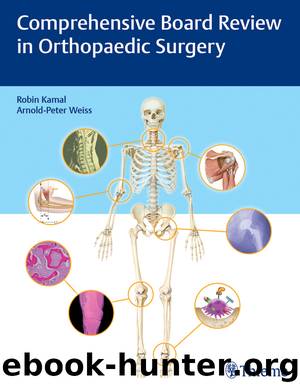Comprehensive Board Review in Orthopaedic Surgery by Robin Kamal Arnold-Peter C. Weiss

Author:Robin Kamal,Arnold-Peter C. Weiss
Language: eng
Format: epub
Publisher: Thieme Medical Publishing Inc.
Published: 2004-06-15T00:00:00+00:00
b. Type I fractures are nondisplaced and can be immobilized in extension for 6 weeks.
c. Type II fractures are displaced and should be reduced and fixed with likely removal of loose prosthesis.
d. Type III fractures have an intact extensor mechanism with a loose patellar component that should be removed.
e. If unsalvageable:
◦ Patellectomy, must have PS implant
◦ Wound breakdown
♦ Most blood supply enters medially (medial superior and inferior geniculate arteries).
♦ Lateral superior geniculate artery is very important to maintain after medial parapatellar arthrotomy; can lead to AVN of the patella and fracture.
▪ At risk with lateral release
• Anterior knee with multiple incisions
a. Attempt to use or incorporate the lateralmost incision acceptable for exposure to preserve medially based blood supply to the skin overlying the anterior knee. If new incision necessary, try to maintain 7-cm skin bridge.
• Prior trauma with tissues loss
b. When planning for TKA through scarred skin and tissue, subcutaneous soft tissue expanders can be used to mobilize excess skin in the preoperative period.
◦ Saline is placed within the spacer each week to expand the skin about the knee. The spacer is removed at the time of TKA.
• Chronic infection with tissue loss or wound healing issues
a. Medial gastrocnemius flap
◦ Proximally based blood supply from medial sural artery
◦ Good excursion, can be used all the way to the lateral side for coverage
b. Lateral gastrocnemius flap
◦ Can only be used for lateral defects
◦ Proximally based blood supply from lateral sural artery
♦ Pulled over peroneal nerve leading to frequent nerve palsy
14. Extensor mechanism disruption
• Patellar tendon injury more common than quad tendon
a. Marked extensor lag, patella alta
b. Drop-lock knee brace for nonoperative candidates
c. Primary suture repair typically fails
d. Typically need repair of native tendon along with some form of augmentation, either allograft or Marlex mesh
◦ Reconstruction with graft in bone tunnel at tibial tubercle. Postoperative cast for 6 weeks in extension. Rehab with active-assist ROM over 3 months. Patient will regain flexion, but will also likely regain extensor lag.
Download
This site does not store any files on its server. We only index and link to content provided by other sites. Please contact the content providers to delete copyright contents if any and email us, we'll remove relevant links or contents immediately.
| Anesthesiology | Colon & Rectal |
| General Surgery | Laparoscopic & Robotic |
| Neurosurgery | Ophthalmology |
| Oral & Maxillofacial | Orthopedics |
| Otolaryngology | Plastic |
| Thoracic & Vascular | Transplants |
| Trauma |
Periodization Training for Sports by Tudor Bompa(8170)
Why We Sleep: Unlocking the Power of Sleep and Dreams by Matthew Walker(6618)
Paper Towns by Green John(5089)
The Immortal Life of Henrietta Lacks by Rebecca Skloot(4525)
The Sports Rules Book by Human Kinetics(4294)
Dynamic Alignment Through Imagery by Eric Franklin(4118)
ACSM's Complete Guide to Fitness & Health by ACSM(3989)
Kaplan MCAT Organic Chemistry Review: Created for MCAT 2015 (Kaplan Test Prep) by Kaplan(3940)
Introduction to Kinesiology by Shirl J. Hoffman(3726)
Livewired by David Eagleman(3684)
The Death of the Heart by Elizabeth Bowen(3552)
The River of Consciousness by Oliver Sacks(3541)
Alchemy and Alchemists by C. J. S. Thompson(3451)
Bad Pharma by Ben Goldacre(3356)
Descartes' Error by Antonio Damasio(3230)
The Emperor of All Maladies: A Biography of Cancer by Siddhartha Mukherjee(3066)
The Gene: An Intimate History by Siddhartha Mukherjee(3047)
The Fate of Rome: Climate, Disease, and the End of an Empire (The Princeton History of the Ancient World) by Kyle Harper(3003)
Kaplan MCAT Behavioral Sciences Review: Created for MCAT 2015 (Kaplan Test Prep) by Kaplan(2940)
